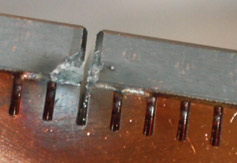
Handy Links
SLAC News Center
SLAC Today
- Subscribe
- Archives: Feb 2006-May 20, 2011
- Archives: May 23, 2011 and later
- Submit Feedback or Story Ideas
- About SLAC Today
SLAC News
Lab News
- Interactions
- Lightsources.org
- ILC NewsLine
- Int'l Science Grid This Week
- Fermilab Today
- Berkeley Lab News
- @brookhaven TODAY
- DOE Pulse
- CERN Courier
- DESY inForm
- US / LHC
SLAC Links
- Emergency
- Safety
- Policy Repository
- Site Entry Form

- Site Maps
- M & O Review
- Computing Status & Calendar
- SLAC Colloquium
- SLACspeak
- SLACspace
- SLAC Logo
- Café Menu
- Flea Market
- Web E-mail
- Marguerite Shuttle
- Discount Commuter Passes
-
Award Reporting Form
- SPIRES
- SciDoc
- Activity Groups
- Library
Stanford
Around the Bay
B-Factory: Full Steam Ahead
 The PEP-II and BaBar teams have found and fixed the vacuum
problem that had limited luminosity to about half normal values for
the past three months. The problem was due to electrical arcing that
damaged two ceramic tiles in the center of a critical vacuum system bellows
near the BaBar detector. This damage created small, sudden releases of
ceramic particles that temporarily spiked vacuum pressure, created
background in the detector, and ultimately tripped off the beam.
The PEP-II and BaBar teams have found and fixed the vacuum
problem that had limited luminosity to about half normal values for
the past three months. The problem was due to electrical arcing that
damaged two ceramic tiles in the center of a critical vacuum system bellows
near the BaBar detector. This damage created small, sudden releases of
ceramic particles that temporarily spiked vacuum pressure, created
background in the detector, and ultimately tripped off the beam.
Since Monday morning, the PEP-II rings have once again been running at high current, well above the currents that had previously caused the arcing. BaBar is already taking data again while the vacuum is being "scrubbed" back to pristine conditions, a normal procedure after the accelerator is turned back on.
"Everybody is very pleased and looking forward to resuming our plans for tripling the data set," said BaBar spokesman David MacFarlane.
The first goal in the coming weeks is to return to the record 1 x 1034 cm-2 s-1 luminosity achieved by PEP-II in October 2005. After that, PEP-II and BaBar plan to continue increasing the peak luminosity by another 20% before the current run ends on July 31. "Discovering and resolving this problem was truly a team effort, with outstanding support from PEP-II, BABAR, MFD, the SLAC shops, and many others," said John Seeman, head of the PEP-II and Linac Accelerator Systems.
Higher currents mean more electrons and positrons per collision, which translates into increased luminosity—the rate of producing physics events that can then be detected and analyzed.
—Heather Rock Woods SLAC Today, April 5,2006